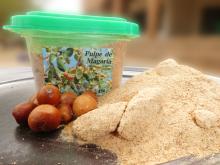Ziziphus mauritiana (jujube tree) is a thorny, drought-resistant shrub that grows between isohyets of 200 and 1000 mm. Very abundant e.g. in the states of Bauchi and Gombe in northern Nigeria. It is a productive tree, of excellent food use. It gives small round fruits, red in color and very succulent. These have a pulp very rich in carbohydrates (80% of dry weight), vitamin C and calcium, with useful contributions in carotene, vitamin A, iron and phosphorus. The pulp also contains 7-12% protein (dry weight).1 2 Inside the fruit is an edible seed, also containing 36% protein, 27% lipids and 21% carbohydrates.3 The foliage is eaten by cattle. But it can also be used for human consumption: although low in protein (7% of dry weight), the leaves are rich in lipids (27% of dry weight) with a good content of linoleic acid, and a value high calcium.4
Flowering occurs after the rainy season, in October-November, and the fruits ripen during the cold season from December to February. The tree is reputed to be able to bear 80 to 130 kg of fruit per year in the Sahel.5
The Sahelian variety of Z. mauritiana differs from those of Asia. The fruits are rounder, smaller, and have a lower water content. This means that they are very suitable for preservation by drying, and the loss of nutrients, including vitamin C, is modest during this process.6 The dried pulp is easily transformed into flour, which is used to make breads or cookies. In Niger, Z. mauritiana breads are a traditional product, and two modern companies make cakes or biscuits using this pulp.7
Whole fruits are highly valued by the Sahelian population, and sell easily in markets across the country,8 at a price of around €0.55 per kg.
In the bush, in areas where the plant is abundant, a pastime for children is to eat the fruits and crush then eat the seeds of Z. mauritiana. These children tend not to suffer from malnutrition9. It would be wise to look at the integration of this food in the formulation of food for children in the fight against malnutrition.
1Pascal Danthu, Pierre Soloviev, Anne Totté, Emmanuel Tine, Nicolas Ayessou, Abibou Gaye, Thierno Daouda Niang, Moussa Seck, Moussou Fall. 2001. Caractères physico-chimiques et organoleptiques comparés de jujubes sauvages et des fruits de la variété Gola introduite au Sénégal. Fruits, 2002, vol. 57, p. 173–182..
2SEPASAL database, Survey of Economic Plants for Arid and Semi-Arid Lands (SEPASAL) , Notes NUTRITIONAL VALUE. http://www.kew.org/science-conservation/research-data/science-directory/projects/survey-economic-plants-arid-and-semi Retrieved December 2014.
3Yerima B.I., Adamu H.M. 2011. Proximate chemical analysis of nutritive contents of Jujube (Ziziphus mauritiana) seeds. International Journal of the Physical Sciences Vol. 6 (36), pp. 8079 - 8082, 30 December, 2011.
4 Sena L.P., VanderJagt D.J., Rivera C., Tsin A.T.C., Muhamadu I., Mahamadou O., Millson M., Pastuszyn A., Glew R.H. 1998. Analysis of nutritional components of eight famine foods of the Republic of Niger. Plant Foods for Human Nutrition 52: 17–30, 1998.
5Loveness Kuziwa Nyanga, 2012. Ziziphus mauritiana (masau) fruits fermentation in Zimbabwe: from black-box to starter culture development.
6 Pascal Danthu, Pierre Soloviev, Anne Totté, Emmanuel Tine, Nicolas Ayessou, Abibou Gaye, Thierno Daouda Niang, Moussa Seck, Moussou Fall. 2001. Caractères physico-chimiques et organoleptiques comparés de jujubes sauvages et des fruits de la variété Gola introduite au Sénégal. Fruits, 2002, vol. 57, p. 173–182..
7Il s''agit de la boulangerie / vénoiserie AGAPE à Niamey et de Sahara Sahel Foods à Zinder.
8Eden Foundation, 2009. Eden Info - February 2009: "Eden Fruit for Sale".
9 observation de l’Eden Foundation à Zinder-Tanout, www.edenfoundation.org.

